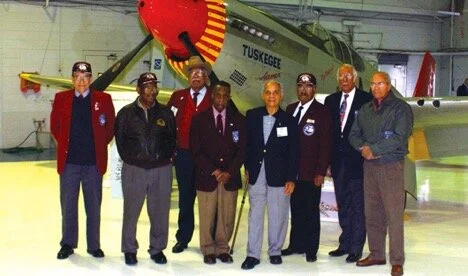From Tuskegee to NYPD
by Adam Durnford
L to R: Tuskegee Airmen Julius D. Mason, John W. Mosley, James E. Harrison, Fitzroy “Buck” Newsum, Hebert E. Carter, Franklin J. Macon, Samuel C. Hunter and Randolph F. Edwards, in front of a “Red Tail” P-51 at the Colorado Springs Jet Center. (Centennial Journal, 2003, Courtesy Willie Daniel II, http://www.ourshadesofblue.org/photos/Tuskegee.pdf)
Randolph Edwards
May 19, 1927- August 30, 2017
Randolph Edwards was born in Manhattan, New York, the only child of Dauphne and Emmanuel Edwards, immigrants from the British West Indies. By 1930, Randolph was living in a household of 11 in Manhattan. His father is not present in census data, but the head of the household is listed as Francisco MacWilliam, Randolph’s grandfather, born in 1878.[1]
In 1945, Randolph Edwards graduated from Rhodes Preparatory School at the age of 17. Dreaming of becoming a pilot, he enlisted in the U.S. Army Air Force before his graduation ceremony.[2] But the military had a long tradition of treating blacks unequally to whites; all branches of the military were strictly segregated at this time. Segregation brought with it unfair treatment justified by stereotypical notions of racial attributes. The common claim was that blacks were unfit for combat, “fearful [and] unreliable.”[3] These were the stereotypes that Edwards had to contend with during his life and service to his country. As Thurgood Marshall noted in 1942, “Whether traveling, on duty or on furlough the colored soldier experiences the indignity of segregation.”[4] In a nation that claimed all men were created equal, recruits were judged by the color of their skin instead of merit. Additionally, African Americans were not trusted as leaders (or soldiers for that matter); their segregated units had white commanders.
In 1938, U.S. authorities were wary of the conflicts brewing across the Atlantic and Pacific. A Civilian Pilot Training system was established to prepare for incoming war. In 1939 the segregated colleges of Tuskegee Institute were incorporated. The Alabama location was chosen due to its heavily segregated population, history of training black civilian pilots, and suitable weather. Training required cadets to pass primary, basic, and advanced flight programs. Each of these programs lasted nine weeks. After all three programs were completed, pilots were graduated to officers, then trained to accustom themselves with the specific aircraft they would be flying during the war.[5] In combat, the Tuskegee Airmen destroyed aforementioned stereotypes of inferiority, earning eight purple hearts, among other awards. The Airmen are renowned for losing “significantly less” bombers on their escort missions than any other fighter groups of the war.[6]
Randolph Edwards started pilot training at Keesler Field, Biloxi, Mississippi as an Army Aviation Cadet. Keesler Field, which had been established four years earlier in 1941, housed 7,000 black troops as of 1943. Among this number were radio operators, bombardiers, aviation mechanics and technicians, and pre-aviation cadets like Edwards.[7] He was then moved to Tuskegee where he became a member of class 46D of the Tuskegee Airmen. The war soon ended before Edwards was able to see combat, and he was assigned to the Reserve.
In the years following World War II, debates on segregation raged. At this time, in 1946, Edwards attended the University of California, and would go on to tour the West Coast as a theater actor. In 1947 he returned to New York for more education until he was recalled back into military deployment.[8] In 1948, President Truman signed Executive Order 9981, meant to establish a plan to end segregation in all branches of the military. Despite heavy resistance within the U.S. Army, the newly established Air Force made the best progress. Bolstered by its “small but visible cadre” of black officers, trained as Tuskegee Airmen, rapid integration was planned and executed upon. African American pilots’ transition to integrated units was achieved “with little incident” and by 1950, the Air Force announced that it neared full integration.[9] This was well ahead of the Army, which did not integrate until after the outbreak of the Korean War, reluctantly, and due to mounting problems within the campaign.
During this time period Edwards served in the Air Force as a member of the Air Police Squadron in New York. He was then stationed at Langley Airforce Base, where he served as a Virginia Honor Guard. In 1954, Edwards married and began his career in law enforcement as a New York State Police Highway Patrolman. He moved on to spend 27 years with the New York City Police Department. He served as a member of the Communications Bureau, the Detective Division-Criminal Identification Unit, and the Narcotics and Special Investigations Units.[10]
While in the police force, Edwards managed to find some time to continue traveling.In 1960 he visited Montenegro Bay, Jamaica,[11] and stopped by Copenhagen in 1962.[12] It is not surprising then, that Edwards headed abroad once more after his 1980 retirement from the NYPD.After this retirement, Edwards worked as a photographer for a German travel magazine.He and his wife spent two years in Copenhagen and another eight in Germany until he returned to the United States in 1996.Randolph F. Edwards died of natural causes in 2017.[13] He was a man who overcame the oppressive attitudes of his day and staked out a fulfilling life for himself.











